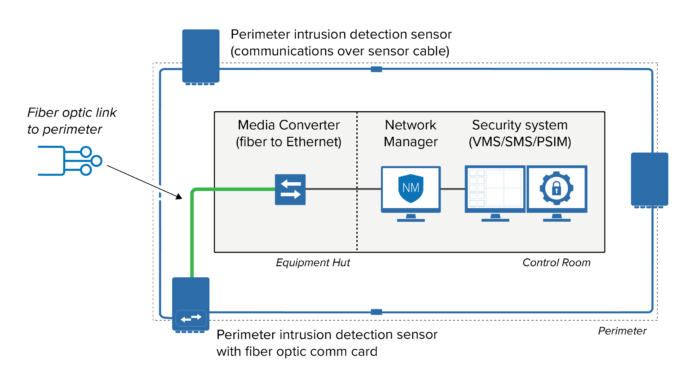Why Use Fiber Links for Perimeter Communications

When assisting system integrators, A&Es and end-users with physical security site designs, the topic of network communication links to edge devices like fence or buried perimeter intrusion detection sensors, as well as IP surveillance cameras, often arises. Senstar supports a range of networking and integration interfaces for its perimeter intrusion detection sensors, including Ethernet, RS-422, and fiber (single and multi-mode), as well as the repurposing of dark fibers within the sensing cables themselves.
While each physical network media has its own merits, in this article, we look at the unique benefits of fiber-based approaches, and how they simplify many site planning issues:
- Electrical Isolation of Indoor/Outdoor Equipment
- Simplified RFI and Induced Current Planning
- Longer Distances at Lower Costs
- High Bandwidth Applications
- Tamper-Resistant Physical Links for Improved Cybersecurity
Electrical Isolation of Indoor/Outdoor Equipment
For sites that have high-voltage equipment near the perimeter, such as electrical transmission and distribution substations, or sites that experience high rates of lightning strikes, electrical isolation of outdoor equipment is a safety issue. While conductive equipment can certainly be safely installed and grounded according to regulations, there is typically additional planning and equipment involved (site surveys, inspections, as-built drawings, lightning arrestors, etc). By linking perimeter devices to the site’s equipment hut via fiber, indoor/outdoor equipment becomes inherently electrically separated and protected via non-conductive connections, and planning is substantially simplified as a result (note however that if conductive armor is used to protect the fiber, the armor must be grounded accordingly).
Simplified RFI and Induced Current Planning
Fiber communication links can mitigate potential radio frequency interface (RFI) in RF noisy environments such as factories or electrical substations. In addition, fiber’s nonconducting materials avoid any possibility of dangerous levels of induced current caused by nearby high-voltage lines. Again, like with electrical isolation concerns, RFI and induced voltage issues can be effectively mitigated with proper planning but with fiber links, these concerns are simply eliminated.

Fiber optic links are nonconductive, simplifying planning and installation when securing sites with high-voltage equipment
Longer Distances at Lower Costs
A key benefit of using fiber communications over twisted-pair cable is coverage distance, especially for extended homerun links back to the control room. Senstar’s single mode fiber optic communication card can communicate over distances of up to 10 km (32,000 feet), while fiber optic sensor cables like FiberPatrol can have lead-in (non-sensing) sections in the 10s of km and can repurpose the unused fibers for network communications. The extended distance simplifies infrastructure requirements for sites with very large perimeters, such as airports or petrochemical facilities.
The per-meter/foot cost of fiber is typically lower than commercial-grade twisted pair, and substantially lower if higher-end multi-conductor cables with improved shielding are required. Installation labor costs are higher with fiber, of course, but its popularity means that the labor pool of certified fiber installers is quite large.
High Bandwidth Applications
Adding intelligent devices and high-resolution cameras (HD or even 4K) to the perimeter greatly improves facility-wide situational awareness. However, this can also increase the amount of data travelling back to the control room. Fiber communication links support a range of network protocols and high-bandwidth applications. Each physical cable contains numerous individual fibers that can be used for different purposes, including sensing for perimeter intrusion detection, sensor status and control, and video streams. Its massive network bandwidth makes fiber highly suitable not just for today’s security applications but future-proofs your site for later upgrades.
Tamper-Resistant Physical Links for Improved Cybersecurity
One concern about adding intelligent devices like sensors or cameras to the perimeter is the risk of sophisticated hackers tapping into the communication cables (especially copper-based Ethernet) in an attempt to trick the control room or security operations center into thinking the sensors and cameras are online when in fact they are not. The risk of these types of attacks can be effectively mitigated via a variety of methods, ranging from low-tech solutions that involve physically securing the cable to the usage of proprietary protocols and the implementation of cybersecurity best practices.
Fiber-based communications simplify cybersecurity concerns even further as it is next to impossible to tamper with fiber communications mid-cable without triggering numerous alarms. To simplify deployment planning, communications can also be implemented as part of a fiber-based sensing solution, which means only one protected fiber backbone to and around the perimeter.

Fiber-based sensing solution in which the individual fibers are used for both communications and intrusion detection
For More Information
For information about the different options available for connecting perimeter intrusion detection sensors to your control room’s video or security management system (VMS/SMS), contact your local Senstar representative.



